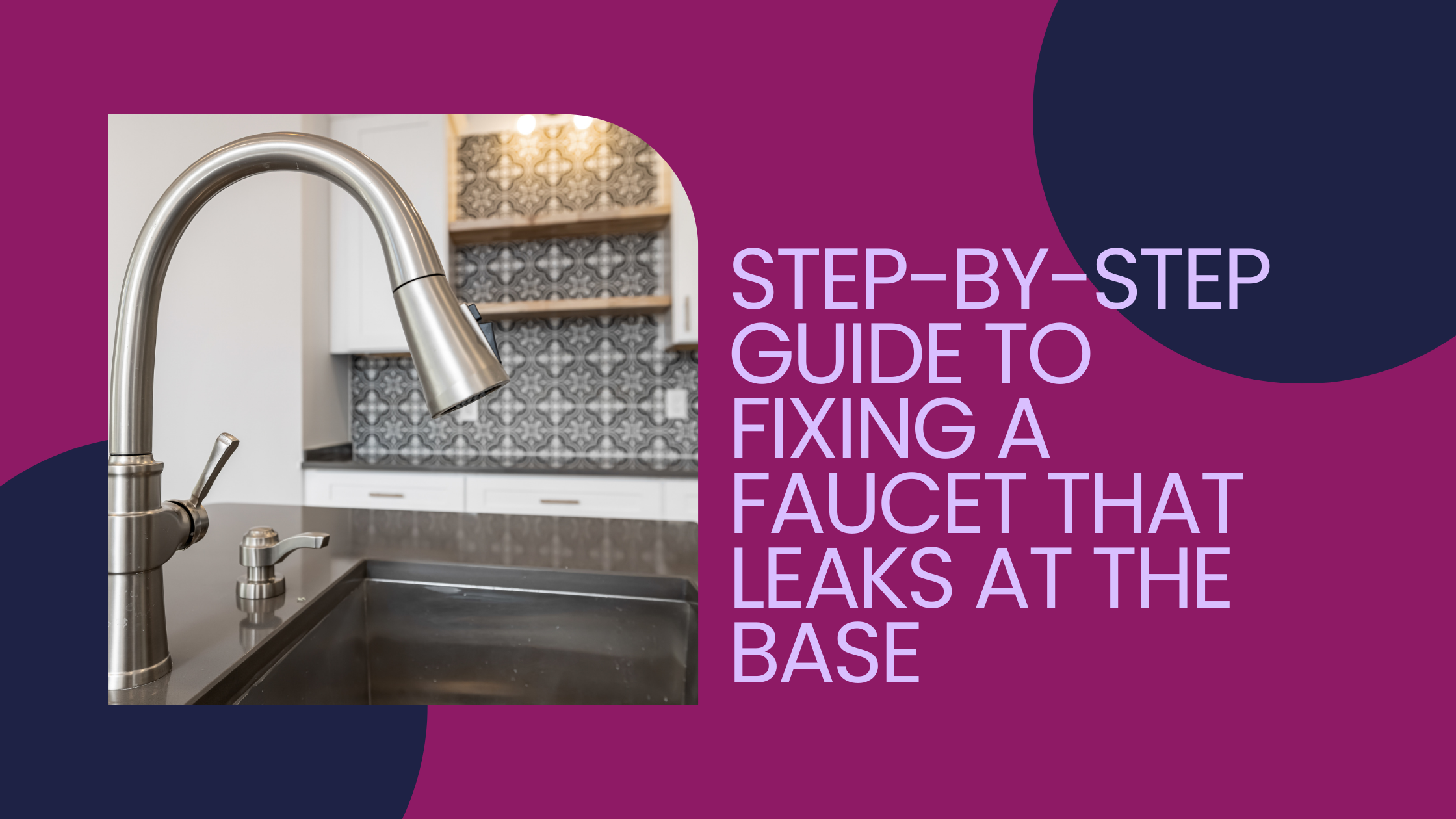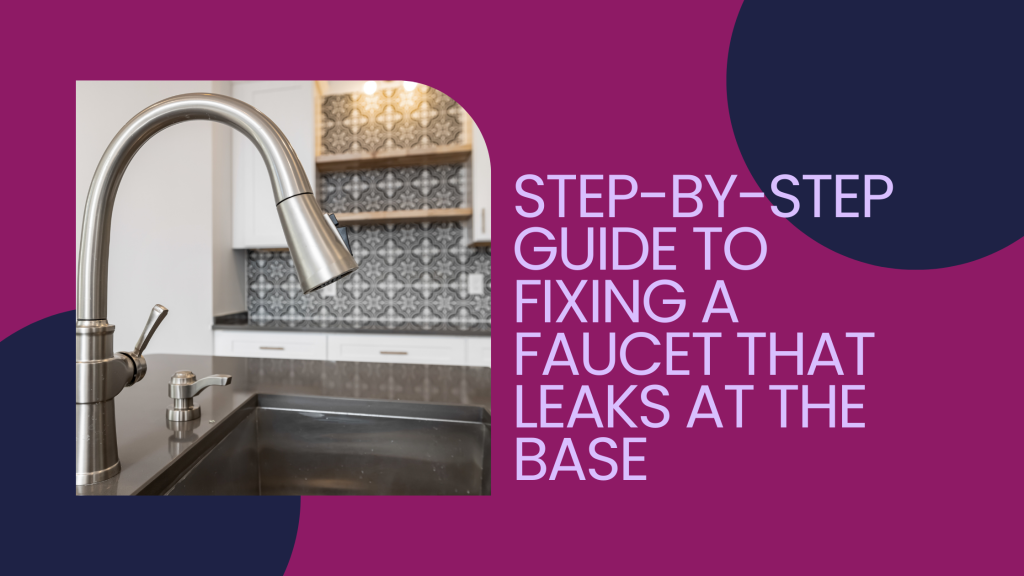A faucet leaking at the base can be a frustrating problem, whether it’s your kitchen faucet leaking at base or a bathroom faucet leaking at the base. Not only is it inconvenient, but it can also lead to water damage if not addressed in time. Fortunately, most faucet leaks at the base can be fixed easily with a few tools and some DIY effort. In this comprehensive guide, we’ll walk you through diagnosing, repairing, and preventing faucet leaks from the base.
Identifying the Cause of the Leak
The first step to fixing a leaky faucet at the base is to identify the cause. Leaks at the base can occur due to a variety of issues, but understanding the source will guide your repair process.
Common Causes of Base Leaks
There are several common reasons why a faucet leaks at the base when turned on:
- Worn Out O-rings or Seals: Over time, rubber seals or O-rings within the faucet may degrade, leading to leaks around the base. This is the most common cause of kitchen sink faucet leaking at the base or bathroom faucet leaking at the base.
- Loose Mounting Nuts: If the faucet is not securely tightened to the sink or countertop, it can cause water to leak underneath. The kitchen sink tap leaking from the base is often due to loose or improperly installed mounting nuts.
- Corrosion or Mineral Buildup: If your faucet is old or has been exposed to hard water, corrosion or mineral deposits can lead to leaks at the base of the faucet.
- Faulty Cartridge or Valve: If you’re dealing with a two-handle bathroom faucet leaking at base, the cartridge or valve may be damaged, causing water to leak when the faucet is turned on.
Diagnosing the Problem
To determine what’s causing the faucet leaking from base and under sink, follow these steps:
- Check for Worn Seals: Remove the faucet handle and check the O-rings or seals for wear and tear. If they appear cracked or brittle, they will need replacement.
- Inspect the Mounting Nuts: Check if the mounting nuts are securely fastened to the sink or countertop. If they’re loose, this could be the cause of your sink leaking from base.
- Look for Corrosion: Examine the faucet’s base and surrounding area for signs of rust or mineral buildup. This could also be contributing to the faucet leaking from base.
Preparing for the Repair
Before diving into the repair process, make sure you’re prepared. Having the right tools and taking safety precautions will make the repair process smoother and more efficient.
Gather the Necessary Tools and Materials
Here are the tools and materials you’ll need to fix your bath tap leaking base or kitchen sink faucet leaking at base:
- Adjustable wrench
- Replacement O-rings or seals
- Screwdriver
- Plumber’s tape
- A bucket or towel to catch any water
- Penetrating oil (if dealing with rust or corrosion)
Shut Off the Water Supply
Before working on any faucet leaks underneath when turned on, ensure you turn off the water supply to the faucet. Typically, there will be a shut-off valve underneath the sink. Turn both the hot and cold water supplies off to prevent water from flowing while you work on the faucet.
Clear the Area
To make the repair process easier, clear the area under the sink. Remove any items that might obstruct your access to the faucet’s base and the water supply valves. Place a towel or bucket underneath to catch any remaining water that may drip out during the repair.
Step-by-Step Repair Process
Now that you’ve gathered everything you need, here’s a step-by-step guide to fixing a sink tap leaking from the base or a faucet leaking at the base.
Step 1: Remove the Faucet Handle
To begin the repair, use a screwdriver to remove the handle of the faucet. Depending on the model, you may need to remove a decorative cap to access the screw that holds the handle in place.
Step 2: Inspect and Replace O-rings or Seals
Once the handle is removed, you’ll likely see the O-rings or seals around the faucet base. If they appear damaged, cracked, or worn, replace them with new ones. This is often the most straightforward solution for a faucet leaking from base issue. Simply slide the old O-ring off and replace it with a new one, ensuring that it fits snugly in place.
Step 3: Tighten the Mounting Nuts
If the kitchen sink tap leaking at the base is due to loose mounting nuts, use an adjustable wrench to tighten them. Check the faucet’s alignment as you tighten it, ensuring it sits flush against the sink or countertop. Be careful not to over-tighten, as this could cause damage to the faucet or sink.
Step 4: Clean the Faucet Components
Before reassembling, clean any mineral buildup or corrosion around the faucet’s base. Use a cloth or sponge to wipe away debris, and if necessary, apply a gentle cleaner to remove stubborn buildup. This will ensure that the kitchen faucet leaking at base issue isn’t caused by blockage or residue.
Step 5: Reassemble the Faucet
Once you’ve replaced the O-rings, tightened the mounting nuts, and cleaned the faucet components, it’s time to reassemble everything. Put the faucet handle back into place, secure it with the screw, and ensure all components are aligned properly.
Testing the Repair
After completing the repair, it’s important to test your work to make sure the leak is gone and the faucet is functioning correctly.
Turn the Water Supply Back On
Turn the water supply valves back on, starting with the cold water and then the hot water. Check for any leaks at the faucet’s base or under the sink. Run both hot and cold water to ensure there are no faucet leaks underneath when turned on.
Monitor for Consistency
Leave the faucet on for several minutes to check if the leak reappears. If you notice water dripping again, it may be necessary to revisit the repair steps, particularly the O-rings or mounting nuts, to make sure they’re securely installed.
Preventative Maintenance Tips
Once you’ve successfully repaired your faucet leaking at the base, it’s important to take steps to prevent future leaks.
Regular Cleaning and Inspection
To keep your bathroom faucet leaking at the base or kitchen sink faucet leaking at the base from happening again, regularly clean and inspect your faucets. Check for signs of wear, mineral buildup, and corrosion every few months.
Avoid Over-Tightening Handles
While it’s important to tighten the faucet components, over-tightening can lead to leaks and damage. Always tighten the parts just enough to ensure a secure fit without applying excessive force.
Schedule Timely Repairs
If you notice a minor drip or leak, don’t wait to address it. Small issues can quickly escalate into larger problems, leading to expensive repairs. Timely intervention can save you money and prevent further damage.

Fixing a leaky faucet at the base is a manageable task that can save you both time and money. By diagnosing the issue, gathering the right tools, and following the step-by-step process, you can restore your faucet to perfect working condition. Regular maintenance and timely repairs will ensure that your bathroom faucet leaks at the base when turned on or kitchen faucet leaking at the base won’t become a recurring problem.



